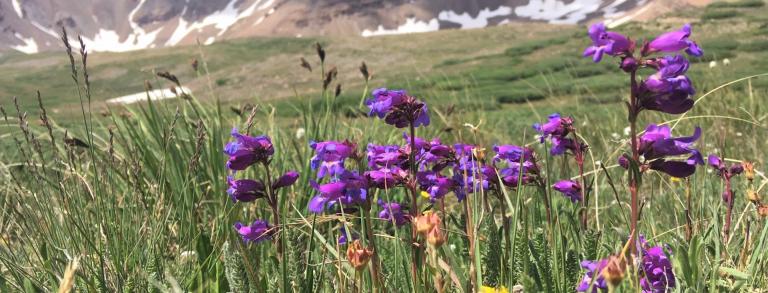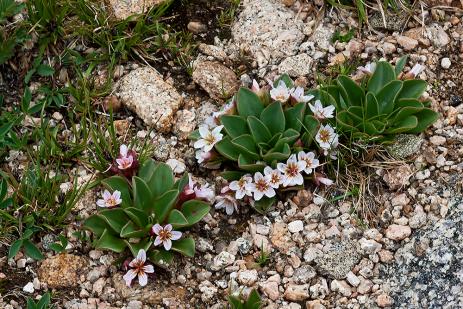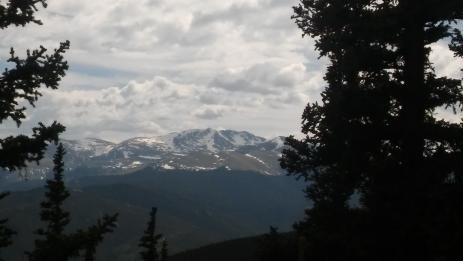I HAVE ALWAYS loved the North American alpine ecosystem, areas above the limit of tree growth, which extends from the northern sea-level tundra of Canada and Alaska, at 11,000 feet (3350 m) and above on the peaks in Colorado and the southern Sierra Nevada, to the southern mountains of Mexico, and west from the coastal volcanic Cascades to the top of Mt. Washington in the east. While many regard these vast ecosystems as largely conserved because they are beyond the reach of man-made disturbance, they are extremely susceptible to change, and climatic change is happening on a global scale.
The alpine plants that inhabit these ecosystems are loved for their beauty but also admired for their toughness and resilience. Who wouldn’t be moved by the image of alpine spring beauty (Claytonia megarhiza) or dwarf clover (Trifolium nanum) clinging to the rocks on top of the Continental Divide. With the expected impacts of climate change on their alpine environment, understanding these remarkable plants and their adaptation to their native habitat has become paramount.
According to a 2019 special report by the United Nations Intergovernmental Panel on Climate Change and Land, anthropogenic warming is projected to shift climate zones poleward and upward into regions of higher elevation. The challenges for alpine plants from a warming climate are unique because in many isolated mountain areas upward movement is impossible. Particularly threatened are those plants that are rare and endangered, including those that are highly adapted such as the well-known alpine forget-me-not, Eritrichium argenteum. The same reasons that make these types of plants so hard to grow is a clue to their probable inability to adapt to warmer conditions.
Scientific data is also showing that the rate of warming is greater at higher elevations. At two high elevation sites in Colorado, temperatures increased an average of 1.2°C (2.1°F) per decade from 1983 to 2007 (Clow, D.W. 2010). This data is supported in many other scientific studies, some of which are referenced in support of these articles.
To play a role in understanding the risk of a changing climate to alpine plants and to project the impact it may have, we have to thoroughly understand their ecology. To this end, educating the public is a critical role for scientific organizations like botanical gardens, but also plant societies like the North American Rock Garden Society (NARGS). NARGS does an excellent job of relating the plants that members grow and nurture back to the ecology of their native habitats, fostering an appreciation of the conditions in which the plants thrive and the habitats in which they have evolved and then using that information as a guide to how they might be grown in captivity. This appreciation is building a community of plantspeoples that could play a critical role in the future of these plants.
Botanical gardens in the modern world are also challenged with being more than a refuge from day-to-day life for gardening enthusiasts and now embrace issues such as sustainability awareness, conservation advocacy, and education. In the United States, increased public interest in conserving natural resources provides a much-needed opportunity to raise awareness about the effect climate change is having on alpine ecosystems. With some 140 million visitors annually, botanical gardens in the U.S. and Canada host nearly as many people as all professional sporting events combined. Gardens have an enormous opportunity to advocate on behalf of threatened ecosystems, and a substantial opportunity to influence public opinion in favor of conserving them.
At 8,200 feet (2500 m) in the ski town of Vail in the southern Rocky Mountains, Betty Ford Alpine Gardens (BFAG) is uniquely positioned to take on the role of advocating for the alpine environment and the strategic initiative in these articles will explain and examine that role. In 2010, while building its 30-year foundation on its collection of world alpine species, Betty Ford was accredited with the National Collection of Colorado’s alpine flora by the American Public Gardens Association (APGA). With over 200 species represented, this is the only North American botanical garden with a collection devoted to Colorado alpine plants specifically, mainly with wild origins. Facilitated by federal seed collecting permits issued by the United States Forest Service and Bureau of Land Management, we have made the development and understanding of this collection a top priority.
Betty Ford Alpine Gardens, in partnership with Denver Botanic Gardens, has created a framework designed to ensure the future of alpine plants and their habitats. The framework is based on two documents: the ‘Global Strategy for Plant Conservation’ first adopted by the Conference of the Parties for the Convention on Biological Diversity in 2002; and the North American Botanic Garden Strategy for Alpine Plant Conservation (2006, updated in 2016). From these templates, we created the North American Botanic Garden Strategy for Alpine Plant Conservation in 2020 with a series of four objectives and associated targets to work towards. First, understand and document alpine plant diversity. Second, conserve alpine species and their habitats. Third, promote awareness of the alpine ecosystem and plant diversity through education and outreach. And fourth, build capacity for the conservation of alpine plant species and associated habitats
The articles in this special issue detail the work being done as part of this effort, not only to directly conserve these plants, but to better understand them and to build the network of both professional scientists and amateur enthusiasts advocating for them. We hope that through the course of these articles readers will feel a call to action and find a way to join us in this important work.
The following articles will discuss the work being done toward the targets in the Strategy at Betty Ford in Vail and how we are working towards some of the basic understandings required, such as a complete list of alpine plants of North America; some of the specialized work on the challenges of banking alpine plant seeds being done at Denver Botanic Gardens; the role of alpine plant collections in botanic gardens and the opportunities for educational outreach. The well-known phrase by Barbara Dioum ‘In the end we will conserve only what we love, we will love only what we understand, and we will understand only what we have been taught’ reiterates the value of learning that gardens can provide. Encouraging a global perspective on the importance of this special and fragile environment is a key strategic objective for the twenty-first century (Sarah Chase Shaw, 2021)
Clow D.W. Changes in the Timing of Snowmelt and Streamflow in Colorado. A response to recent warming. Journal of Climate. 2010;23:2293-2306
Chase Shaw, Sarah (2021) On the Roof of the Rocky Mountains: The Botanical Legacy of Betty Ford Alpine Gardens, Vail’s Alpine Treasure.



